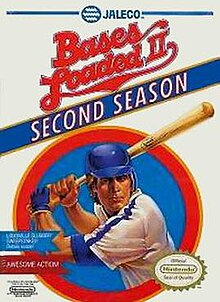Bases Loaded II
| Bases Loaded II: Second Season | |
|---|---|

North American cover art
|
|
| Developer(s) | Tose |
| Publisher(s) | Jaleco |
| Composer(s) | "Sonoda" |
| Platform(s) | Nintendo Entertainment System |
| Release date(s) | |
| Genre(s) | Sports game |
| Mode(s) |
Single-player Multiplayer video game (up to two players) |
Bases Loaded II: Second Season (Moero 3!! Pro Yakyuu '88 - Kettei Ban in Japan) is a video game for the Nintendo Entertainment System released in 1988. It is the sequel to Bases Loaded and is continued by Bases Loaded 3. As opposed to the original, Bases Loaded II (and the sequels) was developed directly for Nintendo's consoles and never saw an arcade version. The game is the second installment of the Bases Loaded series. The game was novelized by Peter Lerangis, as part of the Worlds of Power series published by Scholastic Books.
Like its predecessor, Bases Loaded II offers both a single-game mode and a single- player "pennant race" mode. In the "pennant race", a player must first achieve at least a 75-55 record during the regular season, then win a best-of-7 "World Series" against L.A. or N.Y. depending whether you have chosen a team from the Eastern or Western league respectively.
Though some characteristics remained the same between Bases Loaded and Bases Loaded II (e.g. the same fictitious 12-team league returns in this game, with new players. It is worth noting that all of the players on the Washington, D.C. team are named after famous politicians, while all of Los Angeles's players take their names from Hollywood luminaries. In addition, one of Hawaii's pitchers is named Ho.), there are several noteworthy changes. One new feature was the "biorhythm" concept; players in the game had "biorhythms" that could be monitored to ensure optimal performance. Bases Loaded II had a little faster play action then the original game, and the point of view once a ball was hit into play was also different. In Bases Loaded the view was from behind home plate, whereas in Bases Loaded II the view was either from the first-base line if the home team was at bat, or from the third-base line if the visiting team was at bat.
...
Wikipedia
